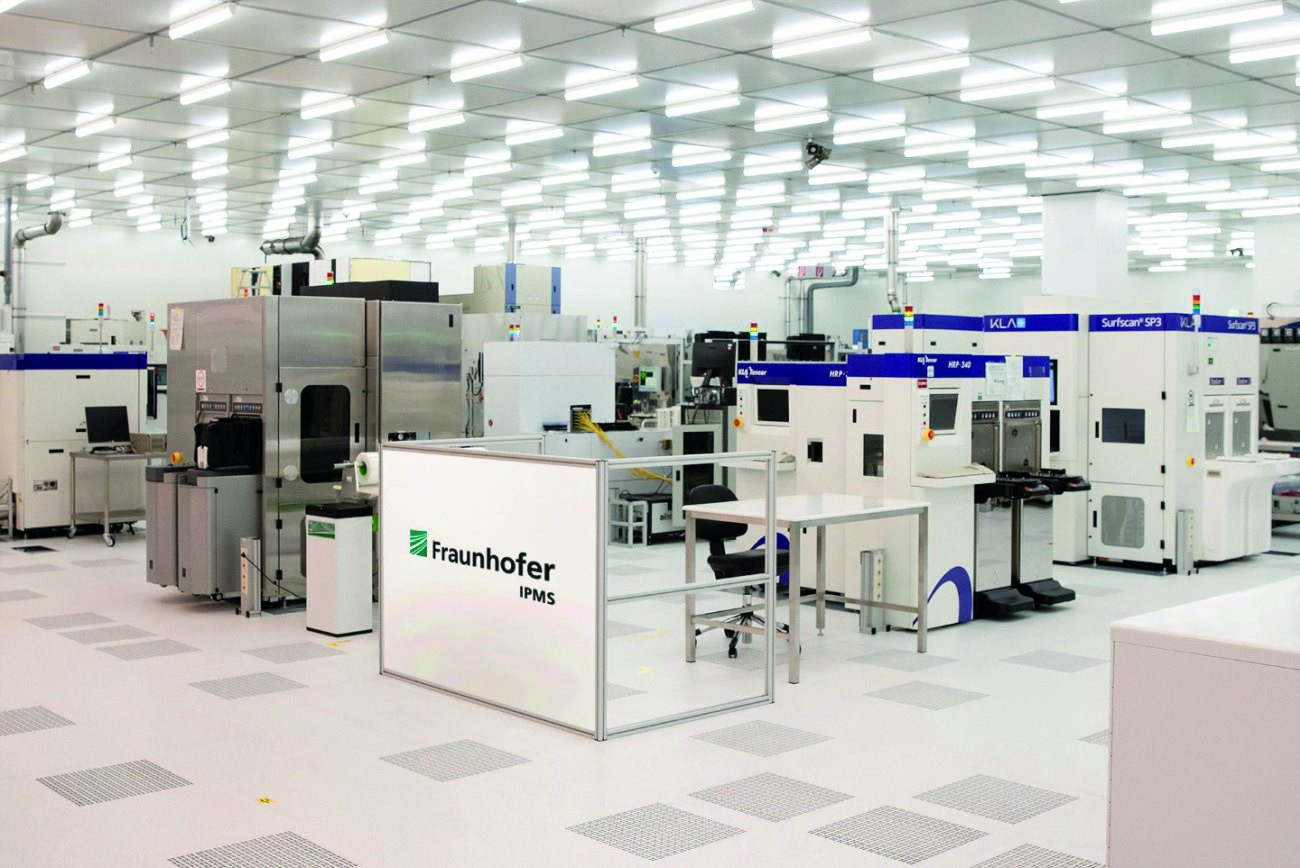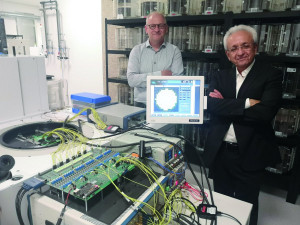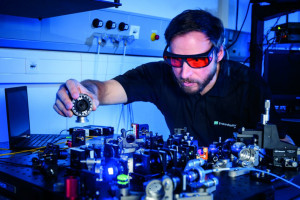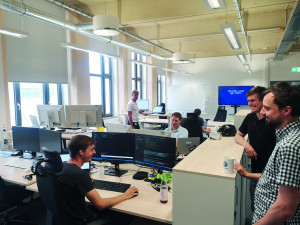Bosch expands chip factory, Fraunhofer expands semiconductor and quantum tech research, Vodafone researches the metaverse in the slaughterhouse.
New industrial investments and research capacities are currently giving the Dresden microelectronics cluster a major boost: Bosch is expanding its recently completed chip factory by a third, Vodafone is setting up a development center for metaverse technologies, VW is expanding its fledgling software factory in the city, while Fraunhofer is merging its microelectronics institutes into a powerful new center and establishing a quantum technology laboratory and other research facilities in the heart of 'Silicon Saxony'. In addition, many smaller settlements with growth potential are strengthening the location.
 Stefan Hartung is Chairman of the Board of Management of BoschAlthoughSaxony's high-tech sector, like German industry as a whole, is currently very concerned about energy prices, wars and a shortage of skilled workers, there is nevertheless a certain sense of optimism. This is partly due to the special microelectronics funding programs from the EU and the federal government - even if not a single cent has yet flowed from them.
Stefan Hartung is Chairman of the Board of Management of BoschAlthoughSaxony's high-tech sector, like German industry as a whole, is currently very concerned about energy prices, wars and a shortage of skilled workers, there is nevertheless a certain sense of optimism. This is partly due to the special microelectronics funding programs from the EU and the federal government - even if not a single cent has yet flowed from them.
Microelectronics and related industries in Saxony have grown even in pandemic times. This is the result of an interim assessment by the Saxon high-tech industry association 'Silicon Saxony'. According to the report, the approximately 2,600 high-tech companies in the Dresden - Freiberg - Chemnitz triangle now employ around 73,000 people, which is 3.6% more than before the coronavirus crisis. Total turnover recently amounted to around €16 billion. "And we will continue to grow," says Frank Bösenberg, Managing Director of the association. He expects over 100,000 jobs to be created in the East Saxon high-tech cluster by 2030.
The latest success story for Saxony's semiconductor industry came from Swabia: The electronics group Bosch is investing €250 million in the expansion of its Dresden chip factory and is also setting up two development centers in Dresden and Reutlingen for €170 million. The Dresden center will employ around 100 experts and focus primarily on semiconductors and microelectromechanical systems (mems) for the automotive industry. This was announced by Bosch CEO Stefan Hartung. The factory expansion in Dresden is also set to begin in 2023: The company wants to increase the cleanroom there by a third to around 13,000 square meters. Among other things, this will create new production capacity for radar sensor mems for the automotive industry.
One reason for this is the continuing tight supply situation for semiconductors in the automotive industry. "We are stepping up the pace in view of the supply bottlenecks in our industries," promised Stefan Hartung - and also outlined the way to get there, which for him involves expanding capacity and using the latest production and quality control technologies. The experience gained in Dresden will serve as a blueprint for other locations.
 4000 m² clean room at the Center for Advanced CMOS & Heterointegration Saxony
4000 m² clean room at the Center for Advanced CMOS & Heterointegration Saxony
"Our plant here is the most modern chip factory in Europe," emphasized Hartung. "Production here in Dresden has already reached a high level of maturity in a very short space of time. It is ramping up faster than planned, having started six months earlier than planned. We are using AI-based quality approval for the first time in the new chip factory. This has enabled us to speed up customer approvals. This is a factory that already demonstrates the future of industrial production - fully networked, full of AI."
Berlin and Brussels have recognized the key role of microelectronics
 Relying on non-volatile ferroelectric memories based on hafnium: (from left to right) Prof. Thomas Mikolajick and FMC CEO Ali Pourkeramati in the new laboratory of 'The Ferroelectric Memory Company'In order to realize the planned expansion in Saxony, Bosch has applied for subsidies from the funding programs for 'Important Projects of Common European Interest in Microelectronics II' (Ipcei-ME II). The company had already received Ipcei subsidies from 2018 for its initial investment in the Dresden Fab, which cost billions. Globalfoundries, Infineon and other players at the site are also already waiting for the green light from Brussels, as they also want to co-finance planned fab expansions with Ipcei billions. In addition, funds from the 'European Chip Act', the draft of which has now been published, will soon be available for follow-up projects. Here, too, the wine has been mixed with vinegar, as the draft only provides for eleven billion euros in EU and state subsidies, which are also to be diverted from other funding pots. Nevertheless, optimism is spreading in Saxony's high-tech industry: Clearly, both Berlin and Brussels have now recognized the special key role of microelectronics for the entire economy.
Relying on non-volatile ferroelectric memories based on hafnium: (from left to right) Prof. Thomas Mikolajick and FMC CEO Ali Pourkeramati in the new laboratory of 'The Ferroelectric Memory Company'In order to realize the planned expansion in Saxony, Bosch has applied for subsidies from the funding programs for 'Important Projects of Common European Interest in Microelectronics II' (Ipcei-ME II). The company had already received Ipcei subsidies from 2018 for its initial investment in the Dresden Fab, which cost billions. Globalfoundries, Infineon and other players at the site are also already waiting for the green light from Brussels, as they also want to co-finance planned fab expansions with Ipcei billions. In addition, funds from the 'European Chip Act', the draft of which has now been published, will soon be available for follow-up projects. Here, too, the wine has been mixed with vinegar, as the draft only provides for eleven billion euros in EU and state subsidies, which are also to be diverted from other funding pots. Nevertheless, optimism is spreading in Saxony's high-tech industry: Clearly, both Berlin and Brussels have now recognized the special key role of microelectronics for the entire economy.
"The opportunities offered by Ipcei and the upcoming EU Chips Act are having an impact: production in Europe is growing," argued CEO Dirk Röhrborn from the Saxon high-tech industry association 'Silicon Saxony', referring to Bosch's expansion plans. This is also an important signal for the European user industries: "It promotes trust in regional value and supply chains and secures Europe's digital sovereignty. The new research and development center that Bosch is locating in Dresden will strengthen the innovative power of the high-tech region of Silicon Saxony and make the location attractive for top talent from all over the world."
Fraunhofer: A beacon of semiconductor research with international reach is being created
 Adjustment of an entangled photon pair source in the Quantum Communication Application Center at Fraunhofer IIS/EAS Fraunhofer has now also significantly strengthened this innovative power in Saxony once again: as already announced in the previous 'Report from Dresden', the research company is now bundling a large part of its microelectronics research in Dresden in a new 'Center for Advanced CMOS & Heterointegration Saxony' (Cachs). "A beacon of semiconductor research with international reach is being created in Dresden," promises Fraunhofer. The center can now map the "complete value chain in 300 mm microelectronics" in a 4000 m² clean room, right through to final assembly.
Adjustment of an entangled photon pair source in the Quantum Communication Application Center at Fraunhofer IIS/EAS Fraunhofer has now also significantly strengthened this innovative power in Saxony once again: as already announced in the previous 'Report from Dresden', the research company is now bundling a large part of its microelectronics research in Dresden in a new 'Center for Advanced CMOS & Heterointegration Saxony' (Cachs). "A beacon of semiconductor research with international reach is being created in Dresden," promises Fraunhofer. The center can now map the "complete value chain in 300 mm microelectronics" in a 4000 m² clean room, right through to final assembly.
Among other things, research will focus on new technologies for front-end production and the packaging of new high-performance chips and chiplets as well as low-energy electronics. The Fraunhofer teams also want to set up pilot lines for new types of electronics, some of which completely abandon current design principles. On the one hand, a pilot line for superconducting quantum processors based on silicon is planned. Another pilot line will produce neuromorphic circuits that are optimized for artificial intelligence (AI).
The researchers led by Fraunhofer specialist Dr. Benjamin Lilienthal-Uhlig want to rely on a technology that 'Qimonda' had originally worked on: non-volatile ferroelectric memories based on hafnium oxide, which work orders of magnitude faster and more energy-efficiently than today's 'memory-capable' memories. Following the bankruptcy of the last major German memory chip manufacturer, the Namlab at TU Dresden continued this project. And the team led by Professor Thomas Mikolajick finally succeeded where many others before them had failed: They constructed hafnium-based non-volatile memory cells that are compatible with common CMOS processes, remain stable over the long term - and switch around 1000 times faster than standard flash chips on the market. In order to commercialize this memory path, the Dresden university has founded a company, 'The Ferroelectric Memory Company' (FMC).
1000 times faster than flash: "We see the opportunity for a huge leap"
This technology may also have the potential to remove the previously rigid boundaries between memory and computing units, i.e. the boundaries of the Von Neumann architecture in today's computer systems. Cachs even believes that the new cells could trigger a medium-sized revolution in nanoelectronics. Fraunhofer, the Namlab at TU Dresden, Globalfoundries and other partners therefore want to build the aforementioned pilot line for neuromorphic computer technology based on this Saxon invention at the new research center. "We see the opportunity for a huge leap with this technology," explains Benjamin Lilienthal-Uhlig.
In order to drive these and other future projects forward, the Cachs workforce is set to grow from the current 133 to up to 200 by 2027. 140 million euros have already been invested in relocations and new facilities. Further multi-million euro expansions are planned for this decade - if the Saxon state parliament provides the planned subsidies in the coming years. Here, too, hopes are pinned on the 'European Chips Act' (ECA): If funding and, above all, subsidies permit, the management duo Wenke Weinreich and Manuela Junghähnel want to greatly expand the Cachs once again with European help.
At the same time, Fraunhofer is closing further gaps in the microelectronics research chain: the Fraunhofer Institute's Adaptive Systems Development (EAS) branch in Dresden has been given a new headquarters for 27 million euros. The five-storey building in the immediate vicinity of the TU campus comprises around 4,300 square meters of floor space. It contains offices, laboratories, test halls, experimental and measuring rooms where researchers can analyze new chip manufacturing processes and test better circuit packaging systems. In this context, the EAS has now also taken on new research tasks: Cognitive sensor technology, the design of complex microelectronic systems, A. I., robot and car electronics, highly reliable circuits and chiplets are now also on the scientific agenda.
New laboratory for quantum communication set up
In their new laboratory for quantum communication, the EAS researchers have already achieved initial successes that make people sit up and take notice: They have already been able to establish quantum-secured communication within the institute building via optical fiber. Next, they want to gradually extend these quantum communication networks to other locations in Saxony and then also to Bavaria and Thuringia. The partners see largely tap-proof and tamper-proof government communication networks for the participating federal states as an important milestone for the future.
Fraunhofer President Prof. Reimund Neugebauer has also heard about this progress: "This puts us at the forefront internationally," he said, praising the Dresden team. On a smaller scale, Neugebauer also took a look into the future for the institute - which is currently a subsidiary of the Fraunhofer Institute for Integrated Circuits (IIS) in Erlangen: if the EAS continues to enjoy such success, it cannot be ruled out that it will ultimately be elevated to the status of an independent institute, the Fraunhofer President orated.
Federal government provides permanent funding for selected AI centers
 Programming and developing in the ambience of a former machine factory: VW's software development center SID after moving to the Universal Works DresdenUniversityAI research in Saxony is also receivingsupport: in order to advance AI in Germany, five German AI research centers will receive around €100 million per year from the federal government and the respective federal states. One of the selected centers is the 'Center for Scalable Data Analytics and Artificial Intelligence' (Scads.Ai) at the universities of Dresden and Leipzig. With the start-up funding from the federal and state governments - initially only granted for a limited period - the Saxon center has already achieved considerable "research strength and excellence", emphasized TUD Professor Wolfgang Nagel, who heads Scads.Ai together with Leipzig Professor Erhard Rahm. "Our goal is to advance this excellence with additional professorships and junior research groups, both in basic AI research and in data-intensive fields of application such as the life sciences and earth sciences." Up to twelve new AI professorships and one Humboldt Professorship are being created at the partner universities in Saxony as part of this process.
Programming and developing in the ambience of a former machine factory: VW's software development center SID after moving to the Universal Works DresdenUniversityAI research in Saxony is also receivingsupport: in order to advance AI in Germany, five German AI research centers will receive around €100 million per year from the federal government and the respective federal states. One of the selected centers is the 'Center for Scalable Data Analytics and Artificial Intelligence' (Scads.Ai) at the universities of Dresden and Leipzig. With the start-up funding from the federal and state governments - initially only granted for a limited period - the Saxon center has already achieved considerable "research strength and excellence", emphasized TUD Professor Wolfgang Nagel, who heads Scads.Ai together with Leipzig Professor Erhard Rahm. "Our goal is to advance this excellence with additional professorships and junior research groups, both in basic AI research and in data-intensive fields of application such as the life sciences and earth sciences." Up to twelve new AI professorships and one Humboldt Professorship are being created at the partner universities in Saxony as part of this process.
The private sector is also currently investing heavily in research capacities in Silicon Saxony: Vodafone plans to open a new development center on the site of the former slaughterhouse in Dresden in autumn 2022. When completed, 200 highly specialized people will develop new technologies for the 'metaverse', the digitalization of medicine, networked agriculture, robotics and the upcoming mobile communications standards. "At the Dresden Hub, we are imagining the future of digitalization," announced Vodafone Chief Innovation Architect Ralf Irmer. "The next generation of mobile communications is being created here with 6G."
Plans for the start-up phase include cooperation with projects that have already been initiated. These include the 5G campus network at BASF in Schwarzheide, the planned large-scale construction research center of TU Dresden in Lusatia and the 'Landnetz' project northwest of Dresden, in which TU, Fraunhofer, Vodafone and other partners have already been testing Agriculture 4.0 and the networked village life of the future for some time. The Group also wants to use the newly acquired expertise in Dresden to expand the 'Smart Rail Connectivity Campus' (SRCC), which is growing in the Ore Mountains, into a leading European rail technology location.
The company now wants to build up a powerful team of programmers and experts in computer clouds, augmented reality (AR), data scientists and other specialists as quickly as possible. In doing so, the communications group is speculating on Dresden's specialist hotbeds such as the TU and HTW and the numerous non-university institutes - and has already begun recruiting.
US automotive electronics group Indie builds up development and testing capacities in Dresden
Indie Semiconductor' is also banking on the engineering potential in Dresden: the US automotive electronics group has founded a German subsidiary here. Indie Germany is primarily intended as a design forge and test center for new automotive chips. The Dresden team specializes primarily in circuits with digital and analogue components that are coupled with ultrasonic or LidDAR sensors and elements of artificial intelligence (AI). The company, which is only two and a half years old, has now relocated within Dresden for the second time due to strong growth. "If we continue to grow like this, we will need another new solution in the near future," says Indie Germany boss Klaus Hermann.
Meanwhile, Volkswagen's development center in Dresden has also grown and has therefore also moved to a larger domicile: From a small start-up team that began work in the glass VW factory in 2019, the 'Software Innovation Development Center' (SID) has now expanded to 50 employees and is set to grow to around 80 heads in the coming years.
VW Innovation Center focuses on factory cloud
The VW Group's core product has been undergoing massive changes for some time now, explained SID Director Uwe Wieland: Electric drives, autonomous driving, connectivity and similar digital features are increasingly helping to determine the market value of a car. At the same time, the production and logistics processes for car factories are changing. This is where VW wants to use more and more AI methods and other modern digital technologies in the future, for which Dresden is particularly predestined: "With the rapid development of the industry-related software industry and the pioneering role of the TU and HTW in communication technology, Dresden has clear locational advantages," says Wieland.
This is precisely where the still young development center is focusing its efforts: Together with the Amazon subsidiary AWS, the Dresden team is developing a completely new digital production platform with its own cloud for Volkswagen Group plants worldwide. The 50 experts are also working on specific application scenarios: cloud-supported modern component planning for car assembly, the simplest possible ways to train robots for quality control, for example, and systems that can locate all vehicles, containers and components in a factory at all times. All this is intended to reduce production costs and ensure high quality, with which VW is trying to set itself apart from new competitors such as Tesla from the USA or Chinese suppliers on the European market.
Sources
Bosch, Silicon Saxony, FHG, IPMS, Assid, EAS, Indie Deutschland, Volkswagen, Oiger.de


